Kothimbir Vadi
Kothimbir vadi is a delicious savory crisp snack from the Maharashtrian cuisine made with gram flour (besan), coriander leaves, peanut, sesame seeds and spices. These savory, herby and flavorful bites can be pan-fried or deep-fried. They are a popular tea-time fritter snack loaded with coriander leaves (cilantro).
About Kothimbir Vadi Recipe
In Marathi language “kothimbir” or “kothmir” stands for coriander leaves. The word ‘vadi’ means cubes or slices or wedges. So these are basically steamed coriander and gram flour cake cubes that are fried.
To prepare kothimbir vadi is very simple. You need to first prepare a thick batter mixture from the ingredients and later steam it until firm and well cooked. This steamed cake is then cut into squares or cubes which we call as vadi and then fried.

For a low-fat version, you can consider skipping the last frying part and eat the steamed cake bites or vadis as it is. They taste delicious even when not fried.
Alternatively, you can even temper with some oil, mustard seeds, hing (asafoetida) and curry leaves and then add this tempering on the steamed vadi. Then garnish with some fresh grated coconut.
This kothimbir vadi recipe is my mom’s recipe and the one she learned from her Maharashtrian friend. The recipe gives a really tasty kothimbir vadi that I make for our evening snack.
Serve kothimbir vadi with green chutney, coconut chutney or tamarind dates chutney or mint chutney. These coriander fritters also pairs well with plain curd (yogurt) or tomato ketchup.
How to make Kothimbir Vadi
Preparation
1. Heat a tawa or pan or skillet and keep the flame to a low or medium. Add ¼ cup peanuts.

2. Stir at intervals and roast till the peanuts become crunchy. The peanuts skin will also have some brown-black spots on them. Remove them on a plate and let them cool.
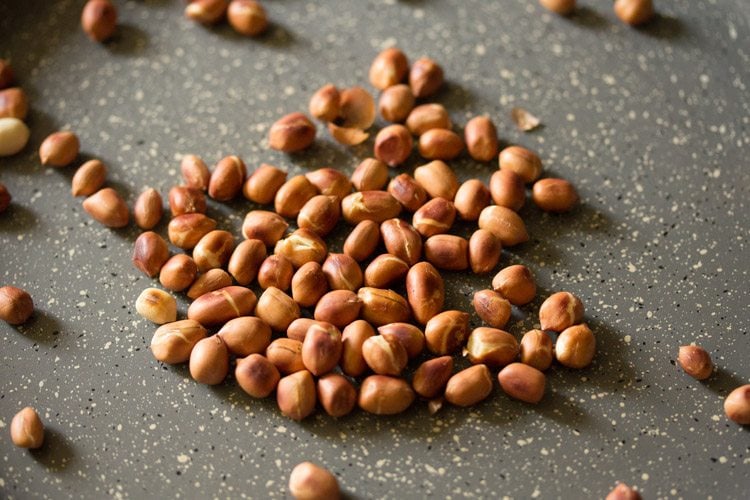
3. Rub the peanuts in your palms. This will remove the flaky skin. Now add the peanuts in a small grinder jar or small blender.
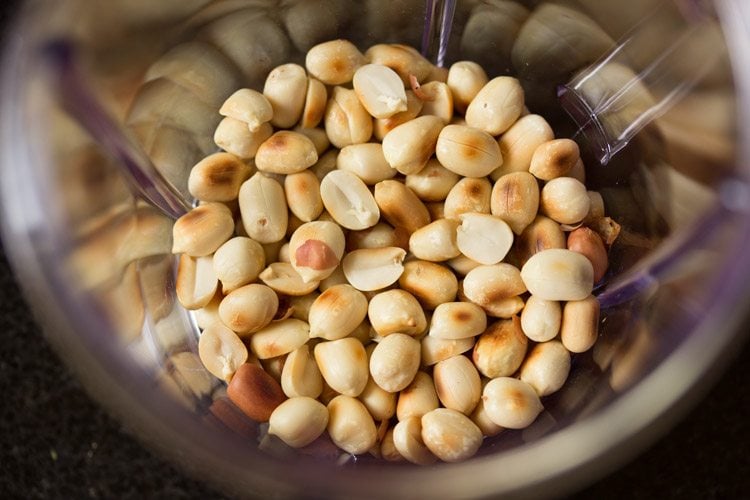
4. Grind to a coarse powder. Remove and keep aside.

5. In the same small grinder, add 1 teaspoon ginger, 1 teaspoon garlic and 2 green chilies (or 2 teaspoons chopped green chilies).
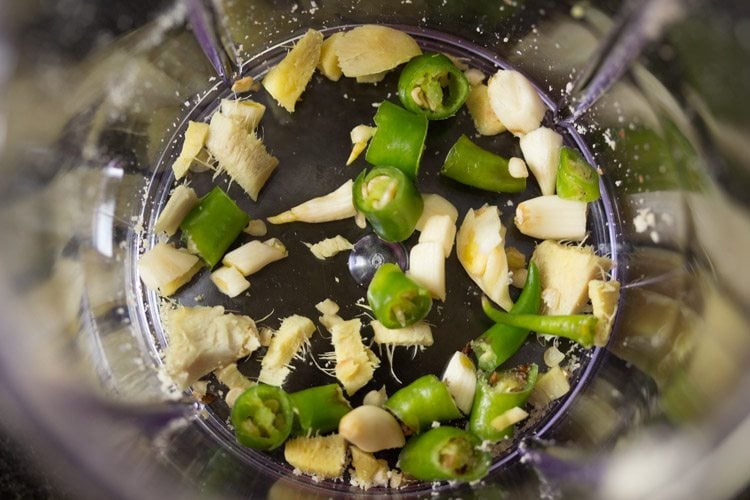
6. Add 1 to 2 tablespoon water and grind to a smooth paste. Keep aside. Alternatively, you can even crush the garlic, ginger and green chilies in a mortar-pestle.
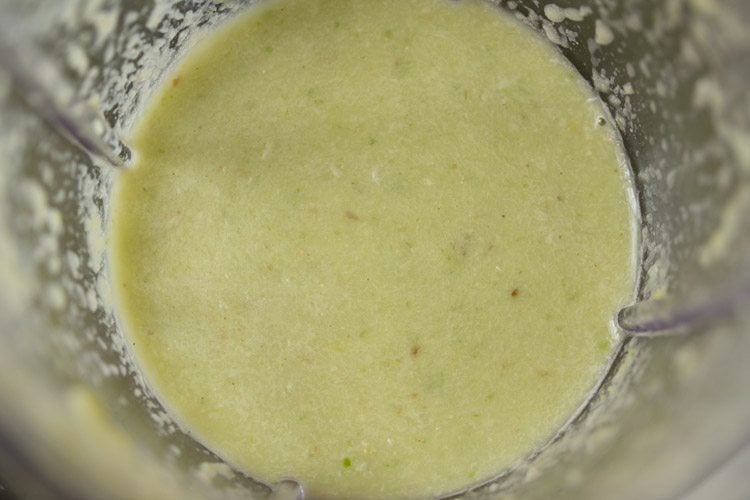
Make Batter
7. Rinse coriander leaves very well in fresh water a few times. Then drain the extra water and finely chop the coriander leaves.
You will need 2 cups of finely chopped coriander leaves. Take the coriander leaves in a mixing bowl.
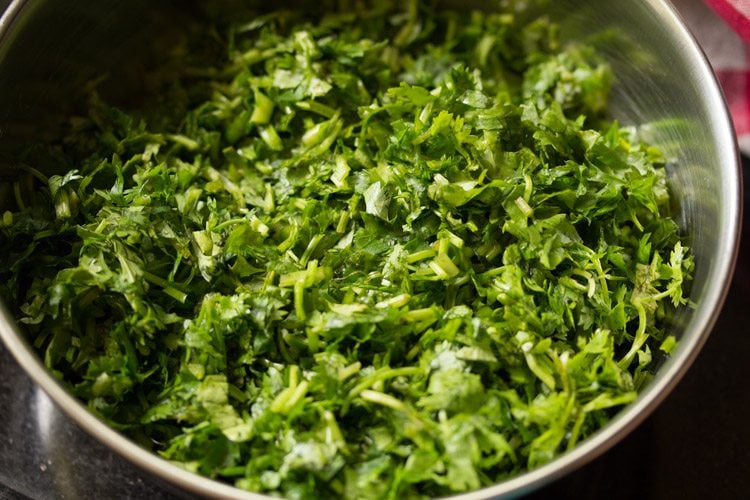
8. Add the ginger+garlic+green chilli paste that we had prepared earlier.

9. Now add the following ground spices:
- ¼ teaspoon turmeric powder
- ¼ teaspoon red chili powder
- ½ teaspoon coriander powder
- ½ teaspoon cumin powder
- 1 pinch of asafoetida (hing) – optional

10. Next add the coarsely ground peanut powder and 1 tablespoon white sesame seeds.
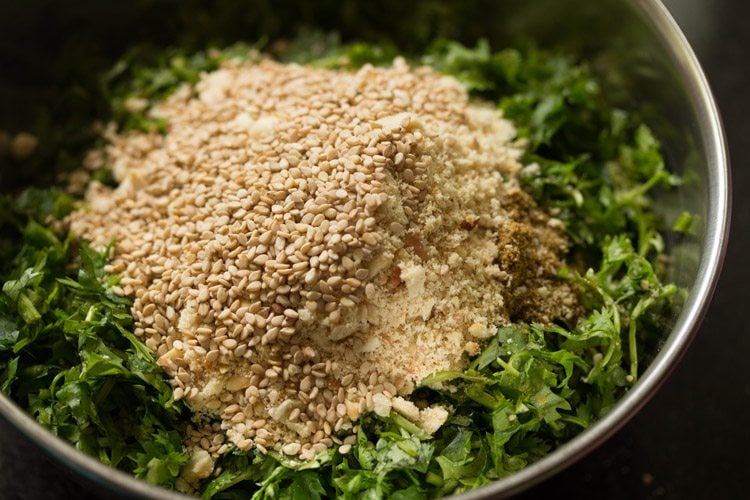
11. Add 1 cup besan (gram flour). Swap chickpea flour with gram flour if you do not have besan.
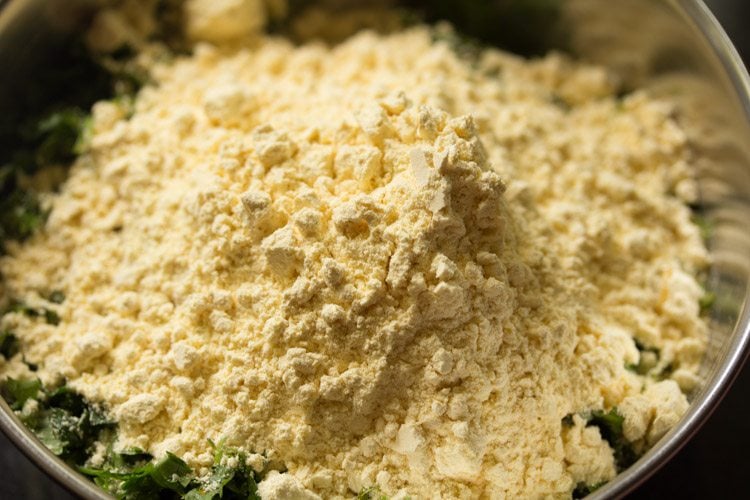
12. Now add ½ teaspoon sugar (optional) and salt as required. You can also add 1 to 2 pinch of baking soda at this step for a more softer texture in the vadi. I am not a fan of baking soda so I don’t add it.
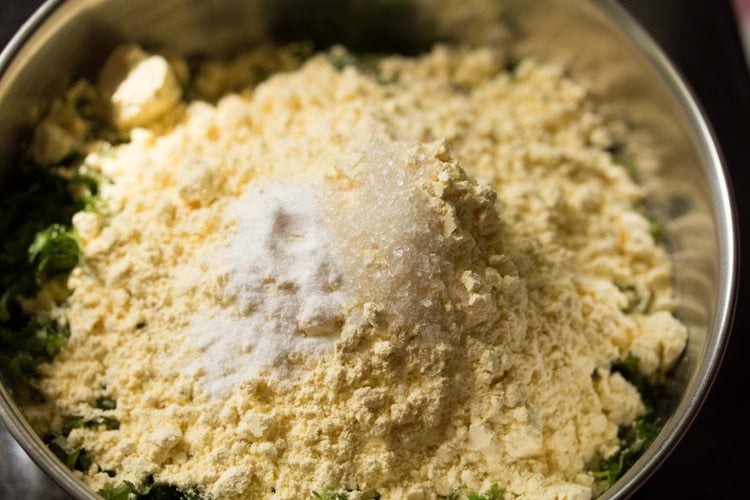
13. Mix everything very well with a spoon.

14. Now add ½ cup water in parts and begin to mix the batter.

15. Mix well to a thick batter. Add water as required and in parts.

Steam Batter
16. Grease a pan very well with some oil. Use any neutral flavored oil or peanut oil.

17. Now add the prepared batter to the greased pan.

18. Bring to boil 1 to 1.5 cups water in another pan. Place a small trivet inside this pan before you begin heating the water.

19. Once the water comes to a boil, lower the heat. Holding with tongs gently and carefully place the pan with the batter on the trivet into the pan with boiling water.

20. Cover with a lid and steam on a low to medium heat for 15 to 20 minutes or until the batter firms up and cooks very well .

21. Once done, check with a toothpick and it should come out clean. When the steamed kothimbir vadi cake is cooled, then gently remove the entire cake on a plate.
To remove the steamed cake, with a butter knife loosen the edges and invert the pan on a plate. Tap the pan and unmold the cake.
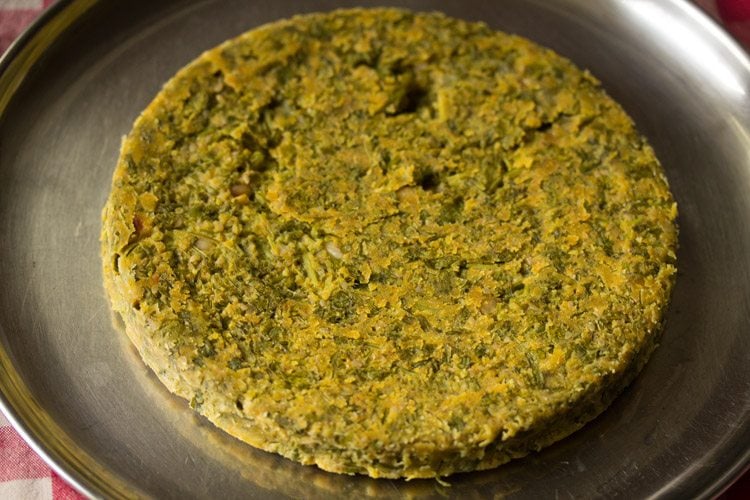
22. Now cut in square or diamond shaped slices as you like.
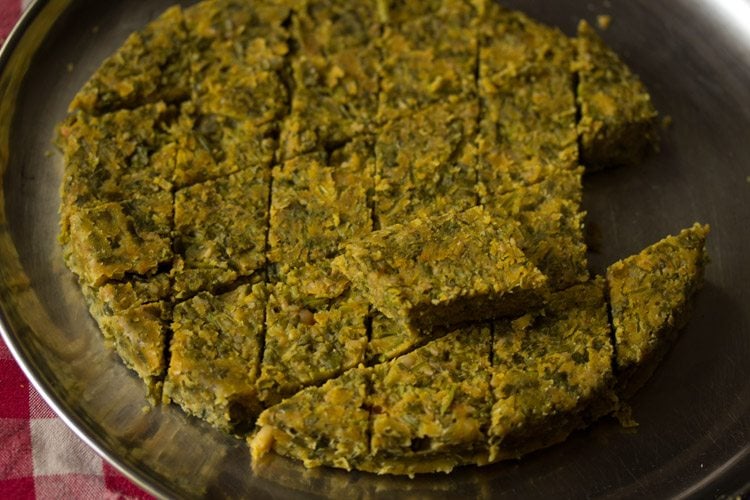
Make Kothimbir Vadi
23. Heat 3 tablespoons oil in a tawa or frying pan or skillet. Place the steamed kothimbir vadi slices and pan fry on medium flame. You can also deep fry if you prefer for a more crispy texture.

24. When the base is golden, flip and fry the other side.

25. Flip a couple of times more and fry till the sides are crisp and golden.
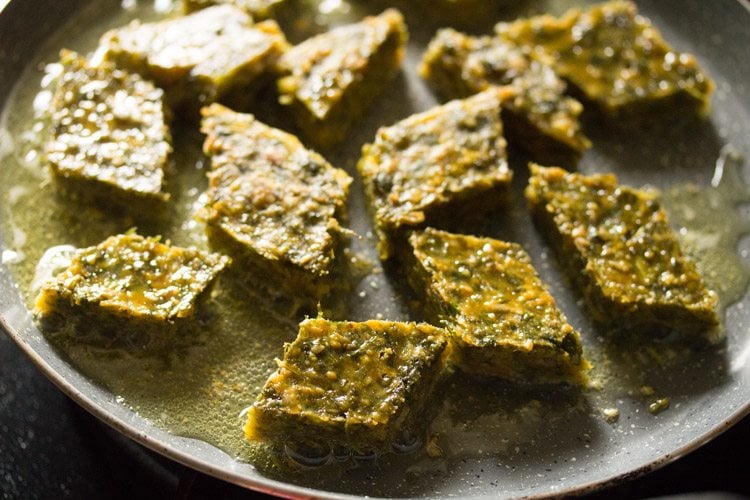
26. Place the pan fried kothimbir vadi on kitchen paper towels for extra oil to be absorbed.
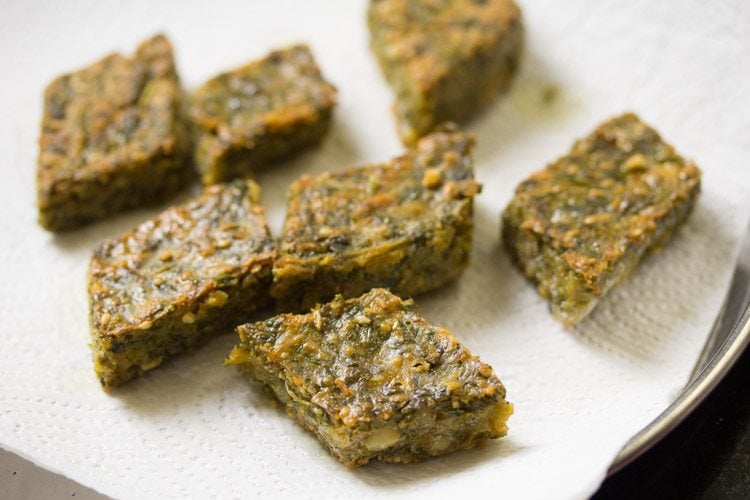
27. Fry the remaining batches in the same way.

28. Serve kothimbir vadi hot or warm with any chutney or sauce of your choice. You can serve them with saunth chutney or coconut chutney or mint chutney or coriander chutney.

Expert Tips
- Use fresh coriander leaves that are tender with a fresh bright green color. Do not use wilted leaves. You can also use coriander stems if they are soft and tender. Coriander leaves are the star of this recipe. So make sure to use the variety which has a more potent flavor and a good aroma.
- You can add less green chilies if you want. For a spicy kothimbir vadi you can either add more green chilies or increase the amount of red chili powder.
- Kothimbir vadi can also be deep-fried instead of pan frying them. Deep frying will give a more crispy texture.
- For a no garlic version, skip the garlic.
- For a gluten-free version, skip adding asafoetida or use gluten-free asafoetida.
- Recipe can be halved or doubled easily if making as a snack for small parties.
If you are looking for more Snacks recipes then do check:
- Alu vadi (pathrode)
- Dhokla recipe
- Palak pakoda
- Hara bhara kabab
Step by Step Photo Guide Above

Ingredients
For roasting peanuts
- ¼ cup peanuts
For ground paste
- 1 teaspoon ginger
- 1 teaspoon garlic
- 2 green chilies or 2 teaspoons green chilies
- 1 to 2 tablespoon water for grinding
Other ingredients
- 2 cups coriander leaves – finely chopped
- ¼ teaspoon turmeric powder (ground turmeric)
- ¼ teaspoon Red Chili Powder or cayenne pepper
- ½ teaspoon Coriander Powder (ground coriander)
- ½ teaspoon Cumin Powder (ground cumin)
- 1 pinch asafoetida (hing) – optional
- 1 tablespoon white sesame seeds
- 1 cup besan (gram flour or chickpea flour)
- ½ teaspoon sugar – optional
- salt as required
- ½ cup water for batter
For steaming
- 1 to 1.5 cups water
For frying
- 3 tablespoons oil
Instructions
Preparation
- Heat a tawa or pan and keep the flame to a low or medium. Add ¼ cup peanuts.
- Stir at intervals and roast till the peanuts become crunchy. The peanuts skin will also have some brown-black spots on them. Remove them in a plate and let them cool.
- Rub the peanuts in your palms. This will remove the flaky skin. Now add the peanuts in a small grinder jar.
- Grind to a coarse powder. Remove and keep aside.
- In the same small grinder, add 1 teaspoon ginger, 1 teaspoon garlic and 2 green chilies (or 2 teaspoons green chilies).
- Add 1 to 2 tablespoon water and grind to a smooth paste. Keep aside. Alternatively you can even crush the garlic, ginger and green chilies in a mortar-pestle.
- Rinse coriander leaves very well. Drain the extra water and finely chop them. You will need 2 cups of finely chopped coriander leaves.
Making batter
- Take the coriander leaves in a mixing bowl.
- Add the ginger+garlic+green chilli paste.
- Now add ¼ teaspoon turmeric powder, ¼ teaspoon red chili powder, ½ teaspoon coriander powder, ½ teaspoon cumin powder and 1 pinch of hing (optional).
- Next add the coarsely ground peanut powder and 1 tablespoon white sesame seeds.
- Add 1 cup besan (gram flour).
- Now add ½ teaspoon sugar (optional) and salt as required.
- Mix everything very well.
- Now add ½ cup water in parts and begin to mix the batter.
- Mix well to a thick batter. Add water as required and in parts.
Steaming
- Grease a pan with some oil.
- Now add the batter in the pan.
- Bring to boil 1 to 1.5 cups water in another pan.
- Lower the flame and holding the pan (in which batter is there) with tongs keep it inside the pan with water.
- Cover with a lid and steam on a low to medium heat for 15 to 20 minutes or until the batter firms up nicely and cooks well.
- Once done, check with a tooth pick and it should come out clean. When the kothimbir mixture is cooled, then gently remove the entire layer on a plate. With a butter knife loosen the edges and invert the pan on a plate. Tap the pan and unmold the layer.
- Now cut in square or diamond shaped slices.
Pan frying kothimbir vadi
- Heat 3 tablespoons oil in a tawa or pan. Place the steamed kothimbir vadi and pan fry on medium flame.
- When the base is golden, flip and fry the other side.
- Flip a couple of times more and fry till the sides are crisp and golden. You can even deep fry them if you want.
- Place the pan fried kothimbir vadi on kitchen paper towels for extra oil to be absorbed. Fry the remaining kothmir vadi in the same way.
- Serve hot or warm with any chutney or sauce of your choice.
Notes
- To make a spicy kothimbir vadi add more green chilies.
- For a more softer texture, you can add 1 to 2 pinches of baking soda in the batter mixture.
- Use fresh and tender coriander leaves. If the steams are tender then you can use them.
- The recipe can be scaled to make a small or a big batch.
- For a gluten-free version skip adding asafoetida or use gluten-free asafoetida.
Nutrition
Kothimbir Vadi recipe from the archives was first published on April 2010.


The recipe sounds easy to understand and it looks delicious!
Glad you found it easy and tasty. Thanks for taking the time to comment.
Very easy and yummy recipe for Kothmir Vadi.
Thank you.
Made kothambir wadi recipe again and again, it turned out perfect,? thank you Dassana.
Thanks Shloka and glad to know.
Please mention time of steaming.
Thanks, will do. The time taken to steam is about 15 to 20 minutes.
Very well explained.Thank you so much for sharing the recipe.
Detailed tips are given which help to make the recipe best one.
Welcome Kiran. Thanks for your positive feedback.
very well explained and its mouthwatering…thank you
Hi, I am curious as to whether the omission of baking soda is on purpose? Other versions I’ve tried have included it. Thanks!
you can add uma. sometimes i also add baking soda. it does help in making the vadi having a soft texture. but just add a pinch of baking soda.
Thank you, I’ll experiment with adding it next time. Meanwhile I am actually really liking the texture of these, and all the cilantro! : )
welcome uma. yes sure experiment both ways by adding baking soda and not adding baking soda.
Hi..i am planning a party ..for 70 people..can i make them in advance…i mean will it taste good after being cold?
you can steam them in advance. but serve immediately after frying.
Hi. I love all your recipes. They are delicious and so easy to follow. And the pictures just keep me drooling. I was just going through the kothimbir wadi recipe i realised that in your ingredients list you have mentioned sesame seeds and in bracket you have written rai. Should it not be til?
Thanks Samrudhi for your positive feedback on recipes. Yes it should be til. Spelling mistake. Thanks for pointing this out.
Hi
Please confirm can we make ahead a couple of days steamed vadi and fry it after a day or two
yes you can do so. but refrigerate the vadis.
I like this recipe
By far the easiest and healthiest way of making kothimbir vadi! Thank you!!
thankyou kuki 🙂 glad you liked the kothimbir vadi recipe.
I m happy
This is a traditional Maharashtrian snack that I have been making for years. A little sourness added to the batter works wonders for this recipe – a tablespoon of sour yogurt or a spoon of tamarind pulp or even a dash of lemon juice. Try it when you make it the next time – my suggestion 🙂
thanks for the suggestions and tips. will surely try 🙂
Hi
Thanks for the recipe. I made it for tea today with my home grown coriander leaves. It was a memorable and happy evening. What chutney have you posted with this recipe? Looks yummy can you share that recipe also please. will serve the family with that chutney next time. This time I served katta meeta chutney.
Regards
Bhuvana
welcome bhuvana. glad to know this. serve with coriander chutney – https://www.vegrecipesofindia.com/coriander-chutney/
Can i please knw wether dis recipe could b prepared in a pressure cooker??
sunita, yes you can steam in the pressure cooker like you steam idlis or dhoklas.
thank u dear. ur recipe is in simple word so finaly i m prepare how to make as easy way..
welcome hiral
Wow I finally got this recipe from your recipybook. I love this recipe a lot. You fully describe it very well. Now trying to make this recipe. Thanks for your guidance.
welcome smita
Yummy
Hey Dassana, thanks for sharing your recipes. I like your detailed and easy explanation of recipes and also tried many of them. Love your blog:)
welcome mitali. thanks for sharing your positive feedback.
Tried it and came out very good. Thanks for your recipe I think 3.30 – 4 mins works out good.
I dont know if you are from Mumbai. But you got to try Kothimbir Vadi from Kanpur Dairy next to the end of Dadar bridge, Dadar (East) near Gurudwara. The lip-smacking taste and the best in Mumbai. Got lot of my friends hooked on to it 😛
thanks yogesh for the feedback. never tried kothimbir vadi from this place. but i know the gurudwara at dadar east. possibly in my next visit, may try. thanks for the info.
easy and nice way it is explained. I hope to make it perfect with theses directions.
Thank you
Tripti
welcome tripti.
thank u so much dassana for this coriander fritter recipe it made my work much easier
welcome asmita
I made this today and it tastes AWESOME! Thank you for sharing 🙂
welcome wong
I tried this recipe and it turned out too awesome. thanks a ton 🙂
welcome deepika
I always wanted to know this recipe…..and i am a greatest fan of koth wadis……thanks a ton dassana…cheers
welcome prashant
Could you please share the recipe of the Indian Veg Biryani?
there are some veg biryani recipes on the blog. most of them are dum biryani except two of them. there are variations in biryani in the different states of india. but all of them taste awesome. i would suggest you to try the following ones, mentioned below. you can search the word biryani using the google search tool bar or check under the category of rice recipes – https://www.vegrecipesofindia.com/recipes/rice-recipes/
1: hyderabad veg biryani – https://www.vegrecipesofindia.com/hyderabad-veg-biryani-hyderabadi-vegetable-dum-biryani-recipe/
2: veg dum biryani, restaurant style – https://www.vegrecipesofindia.com/restaurant-style-veg-dum-biryani-recipe/
3: kerala veg biryani, made with coconut milk – https://www.vegrecipesofindia.com/veg-kerala-biryani-recipe/
4: mushroom biryani – https://www.vegrecipesofindia.com/mushroom-biryani-dum-mushroom-biryani/
Hello Mam,
Can u plz tell how to make chaap at home??
hi mehak. i don’t quite understand what you mean by chaap.
My mother in law makes a curry with these vadis. Something I learned recently from her 🙂
Interesting will be making soon. Thanks for the recipe Dassana.
New recipe to me..A flavor packed one…and as u said preparing in MW makes it quick and hassle free…
I found microwave kothimbir vadi. You can also ive it a try 🙂